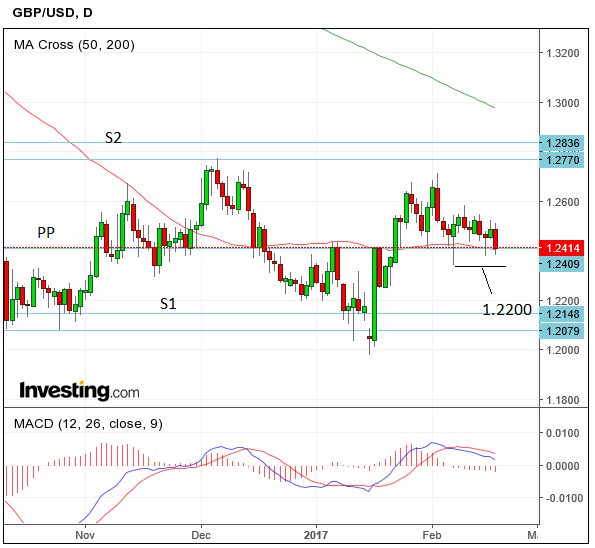GBP/USD Outlook: "Slight Bias to the Downside"

Pound Sterling is trading with a positive tone at the start of the new week and has edged up to 1.2448 against the US Dollar.
The strength will be welcomed by those wanting a stronger Pound as the pair had fallen 0.5% in the previous week taking the market below 1.24 on occassion.
But, the market has shown it does not like to linger below 1.24 at this stage and we therefore look for solid buying interest to be encountered below here going forward.
A daily close sub-1.24 could therefore be bad news for those hoping for a stronger exchange rate from a technical perspective.
It is in the vicinity of 1.24-1.2415 level that both the 50-day moving average and the monthly pivot are situated.
"GBPUSD is sending mixed signals. The pair briefly dipped under its 50-day average near $1.2410 testing $1.2390 before bouncing back toward $1.2430. While this looks like a successful retest, RSI breaking under 50 suggests momentum turning downward," says Colin Cieszynski at CMC Markets.
We are marginally bearish because of the look and feel of the chart, as well as the repeated attempts to break lower which may now finally reap rewards for Sterling bears.
As such we see a slight bias remaining to the downside, which would be confirmed by a break below the recent hammer lows at 1.2344, leading to a target at 1.2200.
The falling trajectory of the MACD appears to corroborate this view as it too looks likely to continue.
Data, Events to Watch for the US Dollar
The week kicks off with the release of Manufacturing and Services PMI in February, on Tuesday, February 21 at 14.45 GMT. If the releases continue in the footsteps of the previous week’s strong results there is a risk they will surprise to the upside.
Housing data and the FOMC meeting minutes are out on Wednesday at 15.00 and 19.00 respectively.
Existing Home Sales are expected to pop higher by 1.0% in January after declining -2.8% in the previous month.
Michigan Consumer Sentiment and New Home Sales round off the week on Friday at 15.00, with the former expected to fall two basis points to 85.5 in February and the latter to rise 7.2% in January after declining a steep -10.4% in December.
A downturn in housing would be a very negative indicator for the economy as it is one of the surest leading indicators.
“There's not much on next week's shortened U.S. calendar to help the Dollar. U.S. markets are closed on Monday for Presidents Day. So while we believe that it is only a matter of time before the Dollar resumes its rise, the bulls could be hanging back until President Trump announces his "phenomenal tax plan," says Kathy Lien, Director at BK Asset Management in New York.
Data, Events to Watch for the Pound
From a hard data perspective, the week kicks off with the CBI Industrial Trends Survey in February on Monday at 11.00 GMT, which is supposed to produce a 3 from a 5 previously.
There then follows GDP data on Wednesday at 9.30, however, these are revisions from preliminary estimates already published, and are not expected to diverge.
At the same time as the GDP is released, we will also see key Business Investment stats for the fourth quarter, which will tell the level with which Brexit concerns are restraining investment, although this has not particularly been the case up until now.
On Friday, February 24 meanwhile we shall see the release of Mortgage stats from the British Banker Association (BBA).
The UK focus seems more likely to shift back to politics over the coming week as on Monday Parliament reconvenes after its February recess.
The House of Lords will begin debating the government’s bill to enable the activation of the Article 50 process to leave the EU.
The bill emerged unscathed through the House of Commons, and the Lords seem likely to make only modest tweaks.
“But the amendments do not seem likely to endanger the government’s end-March timetable for activation. Depending on the extent of the proposed changes, activation could even coincide with the EU Council meetings scheduled for 8-10 March,” says Sawicki.
Should the Lords succeed in making amendments to the Bill we would expect this to be positive for the UK currency.
We have seen over recent months that markets tend to like the idea of increased parliamentary scrutiny as it suggests a ‘softer-Brexit’ is a likely outcome.






